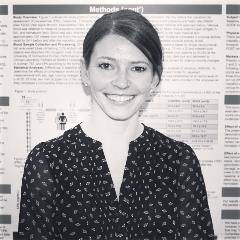Amanda Zaleski |
Feb.
27, 2019

3 Key Points:
- Regular aerobic exercise results in reductions in blood pressure of 5-7 mmHg among individuals with hypertension and these reductions translate to a reduced risk of CVD of 20-30%.
- Emerging research suggests that dynamic resistance exercise may also serve as an efficacious strategy to lower blood pressure to levels similar to aerobic exercise.
- Special consideration should be given to signs/symptoms or presence of disease, concomitant drug therapy, and other comorbidities in order to optimize CVD risk reduction and improve overall health. The goal of preparticipation screening should be to risk classify individuals at risk for an adverse or life threatening response to exercise while decreasing barriers to physical activity participation.
Cardiovascular disease (CVD) is the leading cause of death in the United States (U.S.) and accounts for 1 out of every 3 deaths in U.S. adults. High blood pressure (BP) or hypertension is the most common, costly, but modifiable major risk factor for the development of CVD and premature mortality, affecting nearly half (46%) of U.S. adult population (PMID: 30700139).
Hypertension is the most common, costly, and modifiable CVD risk factor.
In 2017, The American College of Cardiology/American Heart Association Task Force on Clinical Practice Guidelines released new guidelines, which now define ‘hypertension’ as:
- having a resting systolic BP (top number) of 130 mmHg or greater
- having a resting diastolic BP (bottom number) of 80 mmHg or greater
- taking antihypertensive medication
- being told by a physician or health professional on at least two occasions that one has high BP
- or any combination of these criteria

The ACSM recommends that individuals with hypertension engage in moderate intensity, aerobic exercise 5-7 d/wk, supplemented by resistance exercise 2-3 d/wk and flexibility exercise ≥2-3 d/wk.
Participation in regular exercise is a key modifiable determinant of hypertension and is recognized as a cornerstone therapy for the primary prevention, treatment, and control of high BP. On average, regular aerobic exercise lowers resting systolic BP 5-7 mmHg, while resistance exercise lowers resting systolic BP 2-3 mmHg among individuals with hypertension. These BP reductions follow the “law of initial values” such that individuals with
higher baseline BP values experience even
greater reductions in BP from exercise training. In other words, exercise works best in those who can stand to benefit the most.
BP reductions of this magnitude lower overall CVD risk by 20-30%. For these reasons all major public health organizations universally recommend aerobic exercise for the primary prevention and treatment of hypertension. Similar to a drug prescription, individuals can be “prescribed” an exercise prescription for the prevention, treatment, and control of high BP following the FITT principle:
Frequency: How often?
Intensity: How hard?
Time: How long?
Type: What kind?
Specifically, the ACSM recommends the following exercise prescription for individuals with hypertension:
Frequency:
For aerobic exercise, 5-7 d/wk, supplemented by resistance exercise 2-3 d/wk and flexibility exercise ≥2-3 d/wk.
The frequency of aerobic exercise is slightly greater than those with normal BP (i.e., 3-5 d/wk). In fact, individuals with hypertension are encouraged to engage in greater frequencies of aerobic exercise than those with normal BP because we know that a single bout of aerobic exercise results in immediate reductions in BP of 5-7 mmHg, that persist for up to 24 hr (i.e., postexercise hypotension). For this reason, individuals with hypertension are encouraged to exercise on most days of the week in order to benefit from the acute effects of aerobic exercise on BP.
Intensity:
Moderate [i.e., 40-<60% VO2R or 11-14 on a scale of 6 (no exertion) to 20 (maximal exertion) level of physical exertion or an intensity that causes noticeable increases in heart rate and breathing] for aerobic exercise; moderate to vigorous (60-80% 1RM) for resistance; and stretch to the point of feeling tightness or slight discomfort for flexibility.
New and emerging evidence suggest that the magnitude of the BP reductions that result from aerobic exercise occur as a direct function of intensity, such that the more vigorous the intensity, the greater the resultant BP reductions (PMID: 26423529). Individuals who are willing and able may consider progressing to more vigorous intensities, however, the risk-to-benefit ratio has not yet been established.
Time:
For aerobic exercise, a minimum of 30 min or up to 60 min/d for continuous or accumulated aerobic exercise. If intermittent, begin with a minimum of 10 min bouts.
New and emerging research has shown that short bouts of exercise (3-10 min) interspersed throughout the day may elicit BP reductions similar in magnitude to one continuous bout of exercise and may be a viable antihypertensive lifestyle strategy for individuals with limited time.
Type:
For aerobic exercise, emphasis should be placed on prolonged, rhythmic activities using large muscle groups such as walking, cycling, or swimming. Resistance training may supplement aerobic training and should consist of 2-4 sets of 8-12 repetitions for each of the major muscle groups. For flexibility, hold each muscle 10-30 s for 2-4 repetitions per muscle group. Balance training (neuromotor) exercise training is also recommended in individuals at high risk for fall (i.e., older adults) and is likely to benefit younger adults as well.
Blood pressure reductions appear to occur in a dose-response manner such that greater volumes of exercise elicit greater reductions in blood pressure. Progression to the Ex Rx should be gradual, avoiding large increases in any of the FITT components of the Ex Rx, especially intensity for most individuals with hypertension.
A recent meta-analysis demonstrated dynamic resistance exercise training to result in BP reductions similar in magnitude to aerobic exercise training (PMID: 27680663). These results suggest that the antihypertensive benefits of resistance exercise training may have been largely underestimated and warrant reappraisal in the near future. Note that, inhaling and breath-holding while engaging in the actual lifting of a weight (i.e., Valsalva maneuver) can result in extremely high BP responses, dizziness, and even fainting and should be avoided during resistance training.
Practical Applications
Accurate BP assessment is critical for a) the initial diagnosis of hypertension and b) to establish a baseline BP to properly evaluate the influence of lifestyle intervention strategies across time. Proper patient positioning and preparation are critical for ensuring accuracy of BP values. Caffeine, exercise, and smoking should be avoided at least 24 hr before BP assessment. Prior to the first reading, the patient should be:
- seated quietly and not talking for at least 5 min prior to or during the measurements
- legs uncrossed and flat on the floor
- bladder empty
- back supported upright
- arm supported at heart level
- with an appropriate sized cuff
American Heart Association standards state that BP should be measured three times in each arm, separated by at least 1 min, and averaged. This is particularly important given that the first reading is often the highest reading. Preferably, the same exercise professional should measure BP on the same patient and using the same BP monitoring device. Approximately ~25% of patients experience “white-coat hypertension” such that BP readings obtained in the presence of a healthcare provider appear elevated, however, home or ambulatory BP values are within normal ranges. Patients with suspected white-coat hypertension may be referred to their healthcare provider for proper evaluation.
Appropriate preparticipation health screening should be implemented to identify at-risk individuals who may require medical clearance before they begin an exercise program (PMID: 2647375). Although exercise is safe for most individuals, there is a small risk of cardiovascular complications in certain susceptible individuals, particularly among sedentary adults with known or underlying CVD who perform vigorous-intensity exercise they do not usually engage in. The ACSM preparticipation guidelines emphasize the public health message that exercise is important for all individuals and largely triages individuals on the basis of current physical activity levels, desired exercise intensity, and the presence of known or underlying CVD, metabolic, and/or renal disease.
As such, individuals with hypertension cleared to exercise (by the preparticipation algorithm or healthcare provider) should be encouraged to progress gradually, avoiding large increases in any of the components of the FITT. Progression should begin by increasing exercise duration over the first 4-6 wk, followed by an increase in frequency and intensity to achieve the recommended volume of 150 min/wk or 700-2000 kcal/wk over the next 4-8 mo. Progression may be individualized based on tolerance and preference in a conservative manner.
Lifestyle modifications, such as regular aerobic exercise, are fundamental for the prevention, treatment, and control of hypertension. When lifestyle interventions are not effective in achieving treatment BP goals, antihypertensive therapy may be required to optimize CVD risk reduction. Whenever possible, an interdisciplinary, collaborative approach involving the patient, healthcare provider(s), and exercise professional will largely improve lifestyle and pharmaceutical adherence, translating to greater BP control and overall health, which is the ultimate goal in the treatment of hypertension.
Recommended Reading:
New Blood Pressure Guidelines
Preparticipation Screening
Author: 
Amanda Zaleski, PhD is an American Heart Association Postdoctoral Fellow in the Department of Kinesiology at the University of Connecticut. She is also a Project Manager and Evidence-Based Credentialed Analyst for the forthcoming ACSM Hypertension Position Stand Update and Co-Chair of the Communications Committee for New England ACSM.